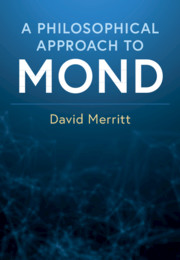Book contents
- Frontmatter
- Dedication
- Contents
- Preface
- 1 The Epistemology of Science
- 2 The Methodology of Scientific Research Programs
- 3 The Milgromian Research Program
- 4 Theory Variant T0: The Foundational Postulates
- 5 Theory Variant T1: A Non-relativistic Lagrangian
- 6 Theory Variant T2: A Relativistic Theory
- 7 Theory Variant T3: A Modified Hard Core
- 8 Convergence
- 9 Summary / Final Thoughts
- References
- Index
5 - Theory Variant T1: A Non-relativistic Lagrangian
Published online by Cambridge University Press: 20 April 2020
- Frontmatter
- Dedication
- Contents
- Preface
- 1 The Epistemology of Science
- 2 The Methodology of Scientific Research Programs
- 3 The Milgromian Research Program
- 4 Theory Variant T0: The Foundational Postulates
- 5 Theory Variant T1: A Non-relativistic Lagrangian
- 6 Theory Variant T2: A Relativistic Theory
- 7 Theory Variant T3: A Modified Hard Core
- 8 Convergence
- 9 Summary / Final Thoughts
- References
- Index
Summary
The second variant of Milgrom’s theory (T1) derives the equations of motion from a Lagrangian formulation, allowing the theory to make predictions for a very general class of systems with arbitrary shapes. A number of confirmed, novel predictions follow from T1 including the “central surface density relation” (CSDR) and a prediction about the form of the vertical force law in the Milky Way. The theory also predicts a very low rate of mergers between galaxies, a prediction that may or may not be consistent with observations. However, the theory’s predictions about the kinematics of the largest bound structures in the universe, the galaxy clusters, appear to be incorrect.
Keywords
Information
- Type
- Chapter
- Information
- A Philosophical Approach to MONDAssessing the Milgromian Research Program in Cosmology, pp. 82 - 116Publisher: Cambridge University PressPrint publication year: 2020
